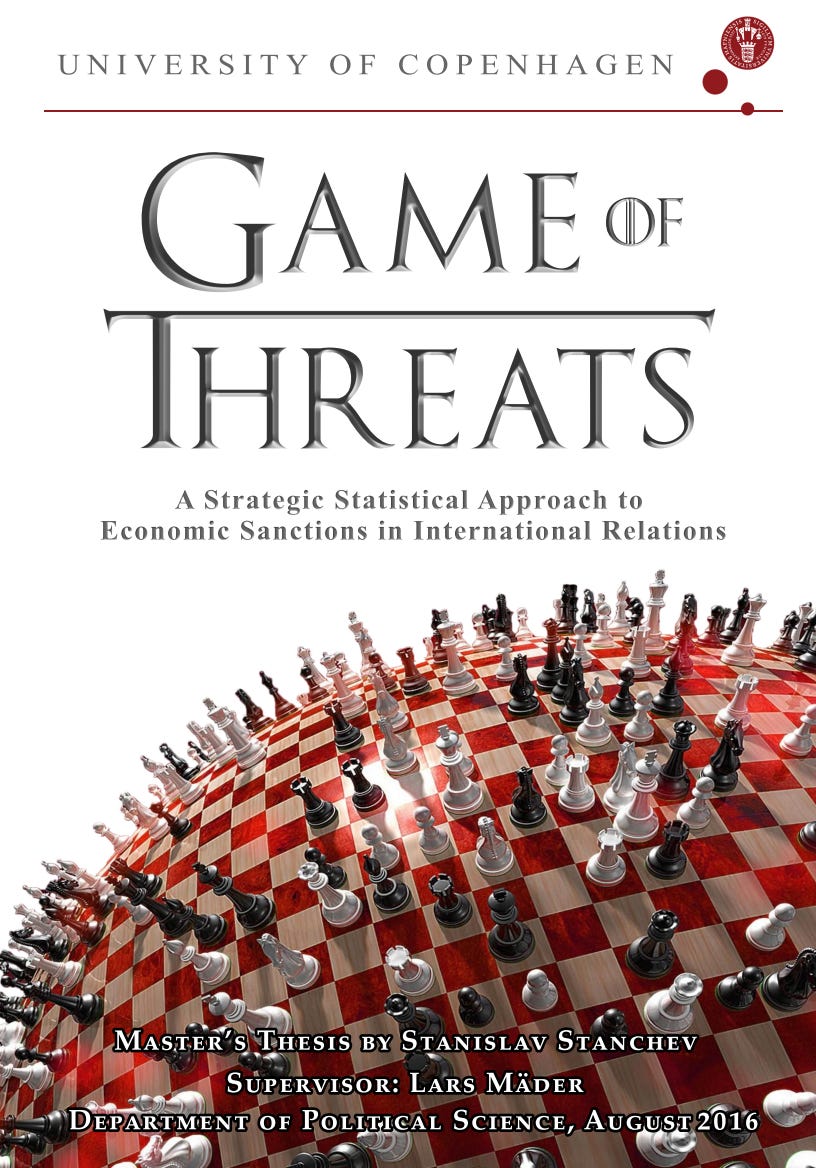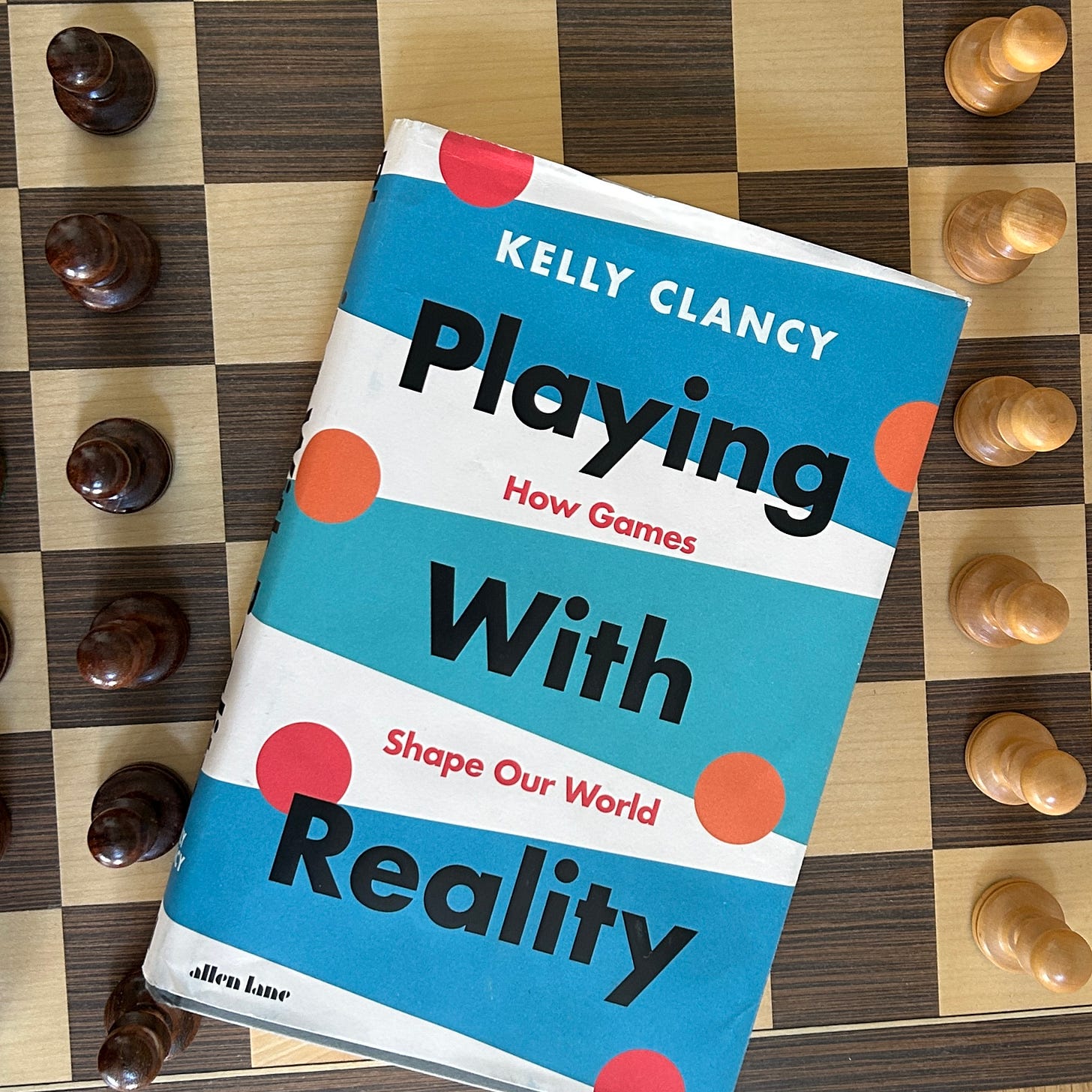Games good, game theory bad
My review of Kelly Clancy's "Playing with Reality - How Games Shape Our World"
One should not judge a book by its cover. Still, there is something about an enticing book cover. In the case of Playing with Reality – How Games Shape Our World, I was not only attracted to the colours and the playful juxtaposition of title and subtitle. What made me smile was the author’s bio on the inside of the dust cover: “Kelly Clancy, PhD, is a neuroscientist and physicist who has held research positions at MIT, Berkeley, University College London and DeepMind. She develops novel brain-computer interfaces with the aim of understanding the principles of intelligence. Her writing has appeared in Wired, Harper’s and The New Yorker. She spent her childhood being repeatedly murdered by her sisters in the video game GoldenEye 007.”
Perfect, I thought as I smiled at that last sentence. This book will be full of interesting neuroscience insights, but with that tongue-in-cheek reference at the end, the author clearly gets games as well. Let’s see how she presents the argument that “the human fascination with games is the key to understanding our nature”, as the less original and more traditionally pop sciency blurb on the front of the dust cover states.
I have to admit that the book’s ambition is both greater and smaller than I anticipated when I received it as a Christmas present under the tree. I mostly expected a chronological study of games from ancient times (dice, chess, Go) through newer inventions like playing cards and the roulette to the current state of designer board games and addictive-by-design “free” mobile games. The ambition is greater than expected because the 300-odd pages deal with themes as diverse as anthropology, neuroscience, military theory, nuclear weapons, economics, evolutionary biology, AI, and crypto currencies. It is smaller than expected because individual games as such feature only sporadically and mostly in support of other arguments. In other words, the seemingly genuine experience of having a good time with GoldenEye 007 does not shine through at all. Instead, it is the curious and well-read neuroscientist on a crusade against game theory that shines through very well indeed.
Terrific opening moves
Playing with Reality starts off very well. I was immediately captured by Clancy’s project. The first chapters deal with the importance of games in a cultural and anthropological sense. Not in a fully predictable and chronological manner, but in a constantly shifting balance between science, culture and history.
Clancy explores the human fascination (and utility) of randomness and chance as a scientific endeavor (Italian scholar Gerolamo Cardano wrote the earliest known treatment of probability, Liber de ludo aleae in the 16th century). She also points out the social implications of games of chance (Cardano gambled his family into poverty on at least one occasion and allegedly wrote his treatise to better be able to cheat at games of dice).
The subject is also looked at from a neuroscientist’s perspective by describing the importance of uncertainty to learning and development (“Studies in human subjects indicate that, in gamblers and non-gamblers alike, dopamine release tracks a stimuli’s unpredictability more closely than it tracks reward.”). Clancy even quotes studies showcasing anthropological and political uses of games: From animal bones as a source of “true randomness” to guide hunter/gatherers away from over-exploiting certain areas to chess as an organizational principle in society (each piece/class/caste has an important role to play).
Middlegame muddled by repetition
Moving away from general observations and surprising insights on dopamine, the development of science and games as metaphors in early modernity, Clancy then devotes a few chapters on the growing role of wargames (“Kriegsspiel” in particular) as a tool in military preparation in the late 19th and early 20th centuries. That is used as somewhat of a bridge to what I consider to be the core of Playing with Reality: Game theory and its many flaws, as Clancy sees them.
The reader is taken on a lengthy ride regarding the invention, development, criticism, infectiousness and lasting impact of game theory. Not as in chess theory on openings and endgames but as in the mathematical treatment of decision-making as pioneered by scientists like John von Neumann.
I believe that the enjoyment and payoff from these chapters will depend on the reader’s prior knowledge of game theory. Writing from an American perspective, where game theory is a particularly dominant framework, I believe Clancy is somewhat justified in explaining, demystifying and repeatedly critiquing the subject. My own exposure to game theory in university was quite nuanced from the very start. Its advantages and drawbacks laid bare already in the first year of political science at the University of Copenhagen (and explored further afterwards). I unashamedly based my own master’s thesis on a game theoretical model of state interaction – not because I believed it would truly say something about the real world, but because it is a neat framework for a research project (indeed, I supplemented the game theoretical analysis with a case study, which did not fit the statistical findings very well at all to no surprise of anyone).
In short, I found Clancy’s lengthy treatment of game theory to be full of repetition – not least of her own (justified!) criticisms of the paradigm. Von Neumann is introduced on page 89, and his shadow lingers upon the remaining 220 pages that are for the most part dedicated to game theory and its good and bad impacts on science, technology and society.

If the reader is not well-versed in this particular subject, I do think Playing with Reality has a lot to offer. And the extent of game theory’s reach in economics and other fields is truly startling. Personally, however, the repetitive focus on game theory made the book’s second half far less enjoyable than its first. It did not help that the unavoidable chapter on chess-playing AI also felt old as only last month I read Kasparov’s Deep Thinking: Where Machine Intelligence Ends and Human Creativity Begins, which covered the development of AI in the context of chess in great detail. All this to say that I felt my reading experience tinged with tedium, which may be reproduced in only a minority of readers!
Despite this doom and gloom, the second half of Playing with Reality still had interesting insights. A memorable variation of Clancy’s critique of game theory’s frequent assumptions of human rationality is expressed thus:
Players behave differently in a prisoner’s dilemma depending on how it’s presented to them. If it’s called the Wall Street Game, players are more likely to defect. If it’s called the Community Game, they’re more likely to cooperate. (p. 120)
The importance of norms in human development is very well-put by the author. And yes, game theory is only useful with the right assumptions, the right context and the right usage. Being aware of its limitations is necessary – and over-reliance on it is problematic (as many examples in the book highlight). However, Clancy is more nuanced than I give her credit for. For instance, she devotes a chapter on the positive intellectual influence of game theory (as a concept) to the development of modern theories on evolutionary biology. I had read Richard Dawkins’ The Selfish Gene and it had a big impact on me. Clancy delves into the giants upon whose shoulders Dawkins stands and gives game theory its due credit as an instrument, when used well.
Fumbles the endgame
The latter chapters deal to some extent with the gamification of contemporary society (from Duolingo to Uber ratings etc.). I was disappointed to find that attention yet again returned to game theory and its impact on e.g. the design of Google’s advertisement auctions. had hoped for recent studies on how video, online, role-playing, and board games affect today’s children and young people. Yes, Clancy quotes that tech companies, influencers and disinformation campaigns exploit how dopamine fires in relation to new and surprising information (whether it is true or not).
But that happens in passing, and the cultural and neurological impact of games (good or bad) in the post-1980s is left completely unexplored. Clancy focuses, in my opinion, too tightly on the direct impact of games (such as SimCity as a society simulator used even in electoral campaigns) and not enough on the indirect impact of games: What are the benefits and pitfalls of people who develop genuine communities around games like World of Warcraft? Are there studies that shed light on changing patterns when we moved from offline console games (Super Nintendo) to online gaming to mobile gaming with horrible things like loot boxes to a growing “reactionary return” to physical board games? These questions are not only left unanswered, they are not even posed by Playing with Reality and I think it is a shame.
A good book for most – a slight disappointment for me
Overall, I still recommend Playing with Reality. It is mostly well-written and contains many nuggets of surprising or interesting information (Clancy knows how to fire up that dopamine, I guess). Its focus on society and science means that the book probably has a much broader appeal than if it stuck more closely to a study of actual games. For that reason, however, I do feel that the tiny references to a Call of Duty here or a Settlers of Catan there feel contrived and dishonest. Game theory takes centre stage – mostly as the villain.
To finish on a positive note, I really did like this quote from the book, which actually touches a nerve with an avid board gamer like myself. It truly summarizes my experience of playing games with my friends and family:
The philosopher C. Thi Nguyen highlights a central aspect of play: though players locked in a game are nominally competing – even in a zero-sum game like chess – they are really cooperating to compete. Players agree to suspend rules of reality for a specific period, adhere to the rules of a game, and work together to achieve the shared goal of an enjoyable time. (p. 161)



